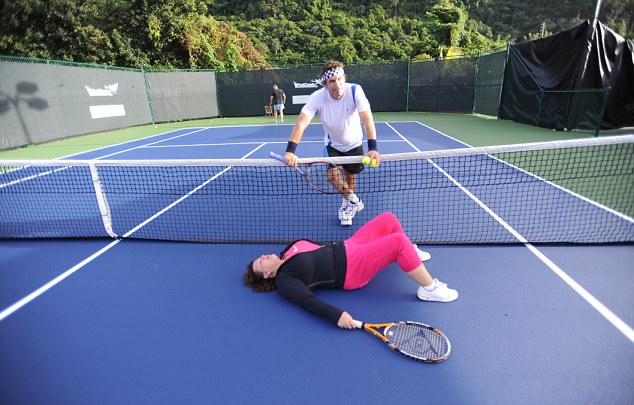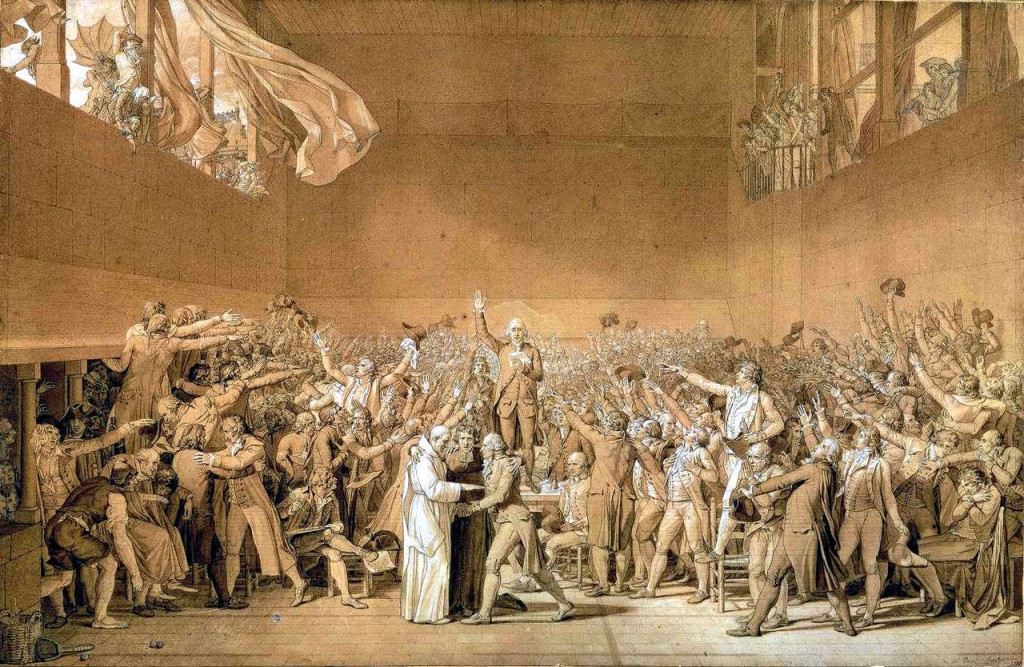The Game of Dead (French) Kings February 8, 2015
Author: Beach Combing | in : Medieval , trackbackTennis, one of the most dangerous games ever created, at least if you are a royal… Beach does not have the exact figures for how many royals ruled Europe from 1000-2000 but an approximate calculation brings up 1200. Of those twelve hundred three died from tennis, a small amount admittedly, a mere quarter of a percent, but that still means that as a monarch you would be far more likely to die from tennis than from Parkinsons, say, or a poker up your anus (Edward II). If we go to the royal family of France from 1000 to dissolution then you had an incredible 5% chance of being killed by le tennis. Even more impressive one of the worst invasions in French history was set off by a gift of tennis balls: at least if we are to believe Shakespeare. ‘We shall in France play a set…’
And as Michael D points out below the French Revolution essentially started in a tennis court with the Tennis Court Oath
So who are the three tennis kings?

First, we have Louis X (of France) who was the first monarch to ever construct indoor tennis courts… He might as well have been training his executioner. In 1316 after a long and exhausting game he made the fatal mistake of drinking a cool draft of wine and died shortly afterwards. It should be noted that drinking long cool things should not kill you but medieval humour theory even blamed long drinks of cold waters for sudden deaths in the melancholic and the phlegmatic. Perhaps Louis had too little heat.

Second was Charles VII, the French monarch who raped Italy. In 1498 the God of Tennis decided to take his revenge for Florence and Naples. Charles was an excited spectator of a tennis game and in trying to get to see the game he ran his head into a door lintel and fell into a coma, dying just hours later. Every city in Italy sent a tennis racket to his funeral: OK the last bit was made up but God he deserved it.

Third, we have the Scottish contribution, 1437. But wait, you are thinking, weren’t Scottish kings always killed by angry cousins? Well, actually yes… James I was being hunted down by the Grahams in his palace when tennis did for him. He sensibly, when he heard angry footsteps, hacked his way through the floor into the sewer, but he couldn’t get out of sewer mouth, because the hole had been netted to prevent tennis balls getting lost! James, it must be said, had jinxed things by renewing the auld alliance with France.
Any other notable tennis deaths: drbeachcombing AT yahoo DOT com And if you are fan don’t worry, unless you spend long periods in France, the chances of death are very low.
10 Feb 2015: Michael D writes in: ‘Re your post about French Kings and tennis: surely as well one might say that Louis XVI’s road to the guillotine started with the Tennis Court Oath?’ Damn I wish I’d thought of this… Thanks Michael!
10 Feb 2015: Mike Dash meanwhile has this extract from his own writing. Note his rider at the end.
‘The death of James I was quite a bit more terrible than the brief account of it you gave, and your readers might like to have it in full. I excerpt from an article i wrote on royals who died in their privies.’
Less controversy surrounds the third and arguably the most gruesome of our royal deaths, not least because only one detailed version of events survives. This is an account given by the English chronicler John Shirley about 15 years after the events it describes – though conventionally Shirley is thought to have had access to a contemporary Latin document written by someone much closer to the scene.
What’s not in dispute is that James was a highly unpopular king. Restored to the Scottish throne after 19 years spent in captivity in England (he had been captured at sea by English pirates in 1406), he appeared back in Scotland with a large ransom to collect. The raising of this payment required extortionate taxes to be levied; the king preferred to concentrate power in his own hands rather than distribute the anticipated patronage; and his efforts to strike back at England ended in expensive military disaster.
Before long a conspiracy was hatched by a group of nobles to remove James. Led by Sir Robert Graham of Kinpunt, its aim was to place Walter, Earl of Atholl, on the throne. The conspiracy came to fruition in February 1437 when the plotters surprised James at the lodgings he kept at a Dominican nunnery in Perth. Forced at short notice to find a hiding place, the powerfully-built king ran to a forgotten privy, tore up a plank from the wooden floor, and concealed himself and a loyal lady in waiting in the overflowing cesspit below.
Here again there are signs that the chronicler who wrote up James’s death used his narrative to make a few pointed comments about the king. The privy, we are told, had drained into an adjacent real tennis court often used by James, and it is added that he had become fed up of losing balls in the sewer that voided it. Shortly before his death, James had therefore had this drain bricked up; had he left it, Shirley says, he would have found it a simple matter to have escaped from the privy-hole that in fact trapped him in a stinking prison.
Thanks to his rashness, the king’s only hope was that his would-be assassins would not discover him, but once they had gained access to the privy (using ‘saws, levers and axes’), the lose plank in the floor was quickly noticed and lifted to reveal James amid the filth below. According to Shirley, what happened next was quite unsavoury. ‘One of the said tyrants and traitours, called sir John Hall, descended down to the king, with a great knife in his hand;’ James fought with him and, being a powerful man, managed to ‘cast him under his feet’ – which must mean submerged him in the accumulated excrement – ‘with full great violence.’ A second assassin then descended into the pit, only to be seized by the neck and hurled down too, so violently that, according to the chronicler,
he defouled them both under him that all a long month after, men might see how strongly the king had held them by the throats, and greatly the king struggled with them for to have bereaved [deprived] them [of] their knives, by the which labour his hands were all forkute [cut].
Finally, Sir Robert Graham jumped down into the void ‘with an orryble and mortelle wepin in his hande’ – no light decision, given the ease with which it would have been possible to pick up a fatal illness in the pit. Refusing James’s plea for mercy, Grahame ran him through with his sword, and – the first two killers having by now freed themselves from the ordure – the king was finished off by all three men. ‘It was,’ Shirley concludes, ‘reported by true persons that saw him dead, that he had sixteen deadly wounds in his breast, withouten many and other in diverse places of his body.’ [Matheson pp.42-3]
Mike continues here for us and I’d concur that stopped must mean bricked rather than a net:
One interesting point here is how exactly the sewer exit had been blocked. You have “netted” and I have “bricked”. Actually the source is vague on this and I was probably making an assumption too much, though, equally, a net seems a flimsy thing to stop a desperate faeces-coated king. Anyway, the original source says merely (I translate from the middle English):
“For beneath at the foot of the stone wall of said privy was usually a hole for the cleansing of the ordure in it, by which the king might well have escaped, had he not only four days earlier had the same hole stopped, because when he played at the game … the ball often ran in at the hole and prevented him playing. And so there was nothing for it but to stay where he was.”
27 Feb 2015: Sue F writes quoting Wikipedia ‘In 1536, Francis III caught a chill after a game of tennis, contracted a fever, and died…’ His death is controversial.




